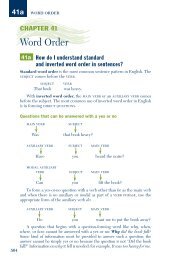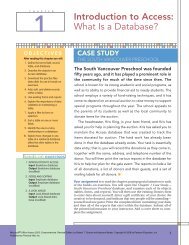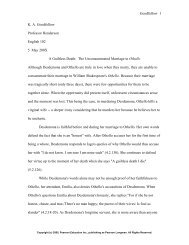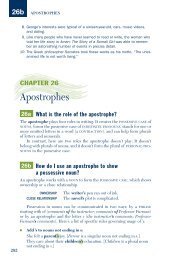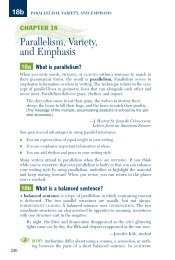JavaScript/JScript: Control Structures I - Pearson Learning Solutions
JavaScript/JScript: Control Structures I - Pearson Learning Solutions
JavaScript/JScript: Control Structures I - Pearson Learning Solutions
You also want an ePaper? Increase the reach of your titles
YUMPU automatically turns print PDFs into web optimized ePapers that Google loves.
2008934301<br />
Chapter 14 <strong>JavaScript</strong>/<strong>JScript</strong>: <strong>Control</strong> <strong>Structures</strong> I 433<br />
It is important to note here that when incrementing or decrementing a variable in a<br />
statement by itself, the preincrement and postincrement forms have the same effect and the<br />
predecrement and postdecrement forms have the same effect. It is only when a variable<br />
appears in the context of a larger expression that preincrementing the variable and postincrementing<br />
the variable have different effects. Predecrementing and postdecrementing<br />
behave similarly.<br />
Common Programming Error 14.10<br />
Attempting to use the increment or decrement operator on an expression other than an lvalue<br />
is a syntax error. An lvalue is a variable or expression that can appear on the left side of an<br />
assignment operation. For example, writing ++(x + 1) is a syntax error because (x + 1)<br />
is not an lvalue. 14.10<br />
The chart in Fig. 14.15 shows the precedence and associativity of the operators introduced<br />
up to this point. The operators are shown from top to bottom in decreasing order of<br />
precedence. The second column describes the associativity of the operators at each level of<br />
precedence. Notice that the conditional operator (?:), the unary operators increment (++)<br />
and decrement (--) and the assignment operators =, +=, -=, *=, /= and %= associate from<br />
right to left. All other operators in the operator precedence chart of Fig. 14.15 associate<br />
from left to right. The third column names the groups of operators.<br />
14.13 A Note on Data Types<br />
Unlike its predecessor languages C, C++ and Java, <strong>JavaScript</strong> does not require variables to<br />
have a type before they can be used in a program. A variable in <strong>JavaScript</strong> can contain a<br />
value of any data type, and in many situations <strong>JavaScript</strong> automatically converts between<br />
values of different types for you. For this reason, <strong>JavaScript</strong> is referred to as a loosely typed<br />
language.<br />
When a variable is declared in <strong>JavaScript</strong> but is not given a value, that variable has an<br />
undefined value. Attempting to use the value of such a variable is normally a logic error.<br />
When variables are declared, they are not assigned default values unless specified otherwise<br />
by the programmer. To indicate that a variable does not contain a value, you can<br />
assign the value null to the variable.<br />
Operators Associativity Type<br />
() left to right parentheses<br />
++ -- right to left unary<br />
* / % left to right multiplicative<br />
+ - left to right additive<br />
< >= left to right relational<br />
== != left to right equality<br />
?: right to left conditional<br />
= += -= *= /= %= right to left assignment<br />
Fig. 14.15 Precedence and associativity of the operators discussed so far.<br />
e-Business and e-Commerce: How to Program, by Harvey M. Deitel, Paul J. Deitel, and Tem R. Nieto. Published by Prentice Hall.<br />
Copyright © 2001 by <strong>Pearson</strong> Education, Inc.




